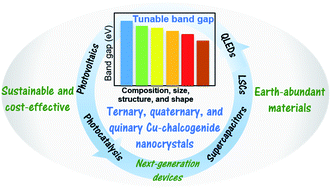Multinary copper-based chalcogenide nanocrystal systems from the perspective of device applications
Abstract
Multinary chalcogenide semiconductor nanocrystals are a unique class of materials as they offer flexibility in composition, structure, and morphology for controlled band gap and optical properties. They offer a vast selection of materials for energy conversion, storage, and harvesting applications. Among the multinary chalcogenides, Cu-based compounds are the most attractive in terms of sustainability as many of them consist of earth-abundant elements. There has been immense progress in the field of Cu-based chalcogenides for device applications in the recent years. This paper reviews the state of the art synthetic strategies and application of multinary Cu-chalcogenide nanocrystals in photovoltaics, photocatalysis, light emitting diodes, supercapacitors, and luminescent solar concentrators. This includes the synthesis of ternary, quaternary, and quinary Cu-chalcogenide nanocrystals. The review also highlights some emerging experimental and computational characterization approaches for multinary Cu-chalcogenide semiconductor nanocrystals. It discusses the use of different multinary Cu-chalcogenide compounds, achievements in device performance, and the recent progress made with multinary Cu-chalcogenide nanocrystals in various energy conversion and energy storage devices. The review concludes with an outlook on some emerging and future device applications for multinary Cu-chalcogenides, such as scalable luminescent solar concentrators and wearable biomedical electronics.

- This article is part of the themed collections: Welcome to the community and Recent Review Articles


 Please wait while we load your content...
Please wait while we load your content...